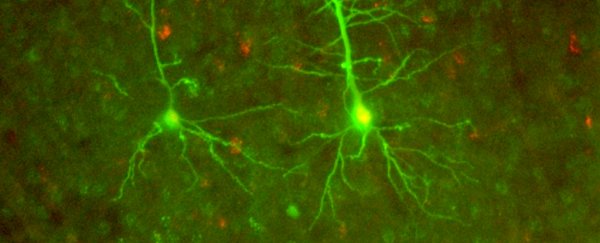Scientists think they've identified a previously unknown form of neural communication that self-propagates across brain tissue, and can leap wirelessly from neurons in one section of brain tissue to another – even if they've been surgically severed.
The discovery, made in February 2019, offers some radical new insights about the way neurons might be talking to one another, via a mysterious process unrelated to conventionally understood mechanisms, such as synaptic transmission, axonal transport, and gap junction connections.
"We don't know yet the 'So what?' part of this discovery entirely," said neural and biomedical engineer Dominique Durand from Case Western Reserve University last year.
"But we do know that this seems to be an entirely new form of communication in the brain, so we are very excited about this."
Before this, scientists already knew there was more to neural communication than the above-mentioned connections that have been studied in detail, such as synaptic transmission.
For example, researchers have been aware for decades that the brain exhibits slow waves of neural oscillations whose purpose we don't understand, but which appear in the cortex and hippocampus when we sleep, and so are hypothesised to play a part in memory consolidation.
"The functional relevance of this input‐ and output‐decoupled slow network rhythm remains a mystery," explained neuroscientist Clayton Dickinson from the University of Alberta, who wasn't involved in the new research but has discussed it in a perspective article.
"But [it's] one that will probably be solved by an elucidation of both the cellular and the inter‐cellular mechanisms giving rise to it in the first place."
To that end, Durand and his team investigated slow periodic activity in vitro, studying the brain waves in hippocampal slices extracted from decapitated mice.
What they found was that slow periodic activity can generate electric fields which in turn activate neighbouring cells, constituting a form of neural communication without chemical synaptic transmission or gap junctions.
"We've known about these waves for a long time, but no one knows their exact function and no one believed they could spontaneously propagate," Durand said.
"I've been studying the hippocampus, itself just one small part of the brain, for 40 years and it keeps surprising me."
This neural activity can actually be modulated - strengthened or blocked - by applying weak electrical fields and could be an analogue form of another cell communication method, called ephaptic coupling.
The team's most radical finding was that these electrical fields can activate neurons through a complete gap in severed brain tissue, when the two pieces remain in close physical proximity.
"To ensure that the slice was completely cut, the two pieces of tissue were separated and then rejoined while a clear gap was observed under the surgical microscope," the authors explained in their paper.
"The slow hippocampal periodic activity could indeed generate an event on the other side of a complete cut through the whole slice."
If you think that sounds freaky, you're not the only one. The review committee at The Journal of Physiology – in which the research has been published – insisted the experiments be completed again before agreeing to print the study.
Durand et al. dutifully complied, but sound pretty understanding of the cautiousness, all things considered, given the unprecedented weirdness of the observation they're reporting.
"It was a jaw-dropping moment," Durand said, "for us and for every scientist we told about this so far."
"But every experiment we've done since to test it has confirmed it so far."
It'll take a lot more research to figure out if this bizarre form of neural communication is taking place in human brains – let alone decoding what exact function it performs – but for now, we've got new science that's shocking in all kinds of ways, as Dickson adroitly observes.
"While it remains to be seen if the [findings] are relevant to spontaneous slow rhythms that occur in both cortical and hippocampal tissue in situ during sleep and sleep‐like states," Dickson wrote, "they should probably (and quite literally) electrify the field."
The findings are reported in The Journal of Physiology.
A version of this article was first published in February 2019.
